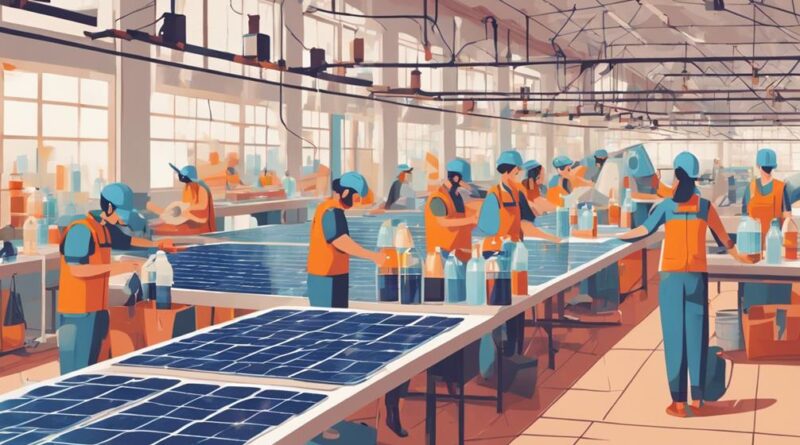Seven Green Solutions for a Sustainable Fashion Industry
Did you know that the fashion industry is one of the largest contributors to environmental damage globally?
By implementing seven key green solutions, the industry can make significant strides towards sustainability.
From embracing renewable energy sources to encouraging responsible consumer behavior, each solution plays a crucial role in creating a more eco-conscious fashion sector.
Stay tuned to discover how these innovative approaches can revolutionize the way we think about fashion and its impact on the planet.
Implementing Sustainable Materials
To create sustainable fashion, start by integrating eco-friendly materials into your designs. Eco-friendly fabrics are a key component in reducing the environmental impact of the fashion industry. By utilizing materials such as organic cotton, hemp, bamboo, and recycled polyester, you can significantly decrease the carbon footprint of your products. These fabrics are produced using sustainable practices that minimize water usage, chemical pollution, and energy consumption. Embracing eco-friendly fabrics not only benefits the planet but also appeals to the growing number of environmentally conscious consumers.
In addition to choosing eco-friendly fabrics, it's essential to focus on the supply chain sustainability of your materials. This involves tracing the origins of your fabrics, ensuring fair labor practices, and promoting transparency throughout the production process. By partnering with suppliers who uphold ethical and sustainable standards, you can guarantee that your materials are sourced responsibly and ethically. Supply chain sustainability also involves reducing waste, optimizing transportation routes, and supporting local communities where materials are sourced.
Adopting Circular Fashion Practices
By shifting towards circular fashion practices, you can further enhance the sustainability of your designs and contribute to reducing waste in the fashion industry. Implementing closed loop systems and eco-friendly manufacturing processes can significantly reduce the environmental impact of your creations. Closed loop systems involve recycling materials and products to create new items, thus minimizing the need for virgin resources and decreasing waste generation.
Incorporating resource-efficient designs into your production process is crucial for adopting circular fashion practices. By designing with the end in mind and focusing on creating garments that can be easily disassembled or recycled, you can promote a more sustainable approach to fashion. Embracing zero waste initiatives, such as pattern cutting techniques that maximize fabric usage or collecting and reusing textile scraps, can further reduce the amount of waste generated throughout the manufacturing process.
Minimizing Textile Waste Generation
Considering innovative recycling methods can effectively reduce textile waste in the fashion industry. By upcycling fabrics, you can give new life to old garments or materials that would otherwise end up in landfills. This process involves transforming waste materials into higher-quality products, promoting sustainability and reducing the industry's environmental impact.
Another crucial aspect to minimize textile waste is by reducing overproduction. As a consumer, you can contribute to this effort by being mindful of your purchases and opting for quality over quantity. Fast fashion's emphasis on quick turnover and constant new releases leads to excessive production and waste. By choosing timeless pieces and supporting brands that prioritize sustainability, you can help combat overproduction in the fashion industry.
Moreover, participating in clothing swaps, donating unwanted items, or selling clothes second-hand can further decrease textile waste generation. By extending the lifecycle of garments, you can reduce the demand for new clothing and lessen the overall environmental footprint of the fashion industry. Embracing a more conscious approach to consumption and supporting initiatives that promote upcycling and reduce overproduction are crucial steps towards a more sustainable fashion industry.
Embracing Renewable Energy Sources
Embrace renewable energy sources to enhance the sustainability of the fashion industry. By investing in energy efficiency and utilizing solar power, fashion brands can significantly reduce their carbon footprint and contribute to a greener future.
Implementing energy-efficient practices within manufacturing facilities and offices is a crucial step towards sustainability. This includes using energy-saving equipment, optimizing lighting systems, and improving overall operational efficiency. By reducing energy consumption, companies can lower their greenhouse gas emissions and minimize their environmental impact.
Solar power is a renewable energy source that offers a clean and sustainable alternative to traditional electricity generation. Fashion businesses can install solar panels on their rooftops or properties to harness the power of the sun and generate clean electricity. Not only does this help in reducing reliance on fossil fuels, but it also leads to long-term cost savings and energy independence.
Embracing renewable energy sources like solar power isn't only beneficial for the environment but also for the bottom line of fashion companies. It demonstrates a commitment to sustainability, attracts environmentally-conscious consumers, and sets a positive example for the industry as a whole. By making the switch to renewable energy, fashion brands can play a significant role in building a more sustainable and eco-friendly future.
Promoting Ethical Production Processes
To enhance sustainability in the fashion industry, prioritize promoting ethical production processes. By focusing on fair trade principles and implementing transparency initiatives, you can ensure that the clothes you wear aren't only stylish but also ethically produced.
Here are some key ways to promote ethical production processes:
- Support Fair Trade Practices: Opt for brands that adhere to fair trade standards, ensuring that garment workers are paid fairly and work in safe conditions.
- Implement Transparency Initiatives: Choose companies that are transparent about their production processes, materials sourcing, and supply chain to ensure ethical practices.
- Encourage Worker Empowerment: Look for brands that empower their workers by providing fair wages, safe working environments, and opportunities for growth.
- Prioritize Sustainable Materials: Opt for clothing made from sustainable materials like organic cotton, bamboo, or recycled fabrics to reduce environmental impact.
- Advocate for Ethical Certifications: Look for certifications like Fair Trade Certified or Global Organic Textile Standard (GOTS) to ensure that the clothes you buy meet ethical production standards.
Encouraging Responsible Consumer Behavior
To ensure a more sustainable fashion industry, you must actively engage in responsible purchasing habits and demand transparency from brands. Educating consumers about sustainable shopping habits is crucial in driving positive change. By understanding the impact of your choices, such as opting for eco-friendly materials or supporting ethical brands, you can contribute to a greener future for the fashion industry.
When it comes to responsible consumer behavior, it's essential to consider the lifecycle of the products you purchase. Choose quality over quantity to reduce waste and invest in pieces that are durable and timeless. Additionally, consider buying second-hand or vintage items to give clothing a new life and reduce the demand for new production.
Demanding transparency from brands is another powerful way to promote sustainability. Ask companies about their sourcing practices, labor conditions, and environmental policies. Support brands that are open about their processes and are committed to ethical and eco-friendly practices. Your voice as a consumer can push companies to prioritize sustainability and make positive changes in the industry.
Investing in Green Technology

Investing in green technology is essential for the fashion industry to reduce its environmental impact and create a more sustainable future. By embracing eco-friendly innovations and sustainable manufacturing practices, companies can make significant strides towards a greener industry. Here are some key aspects to consider:
- Implementing cutting-edge green technology trends can revolutionize manufacturing processes, leading to reduced energy consumption and waste generation.
- Investing in eco-friendly innovations such as waterless dyeing techniques and recycled materials can help minimize the environmental footprint of fashion production.
- Embracing sustainable manufacturing practices, like using renewable energy sources and optimizing supply chain logistics, can significantly decrease carbon emissions.
- Environmental investments in research and development of new green technologies can drive industry-wide change towards a more sustainable future.
- Collaborating with tech companies specializing in sustainable solutions can foster innovation and accelerate the adoption of green technology across the fashion industry.
Collaborating for Environmental Impact
Consider partnering with other stakeholders to maximize environmental impact in the fashion industry. By forming eco-friendly partnerships and engaging in community initiatives, you can amplify the positive changes towards sustainability. Collaborating with like-minded organizations and businesses allows for shared resources, knowledge, and networks, leading to more significant outcomes in reducing the environmental footprint of the fashion industry.
Sustainability-focused campaigns are a powerful way to raise awareness and drive collective action. By joining forces with other brands, influencers, or non-profit organizations, you can reach a broader audience and inspire change on a larger scale. These collaborations can spark conversations, educate consumers, and promote sustainable practices throughout the industry.
Global alliances are crucial for addressing environmental challenges that transcend borders. By participating in international initiatives and partnerships, you can contribute to global sustainability efforts and learn from diverse perspectives and approaches. Working together on a global scale enables the fashion industry to tackle complex issues such as climate change, resource depletion, and waste management more effectively.
Frequently Asked Questions
How Can the Fashion Industry Work Towards Reducing Its Carbon Footprint Beyond Just Using Sustainable Materials?
To reduce its carbon footprint beyond sustainable materials, the fashion industry can embrace a circular economy. This involves recycling, reusing, and minimizing waste throughout the production process. Implementing green manufacturing practices like energy-efficient technologies and eco-friendly materials is crucial. By focusing on circularity and green manufacturing, the industry can significantly decrease its environmental impact and move towards a more sustainable future.
This approach not only benefits the environment but also helps to create a more socially responsible and ethically conscious industry.
What Are Some Innovative Ways That Fashion Brands Can Repurpose and Upcycle Textile Waste?
To repurpose textiles, consider innovative upcycling methods like creating new fabrics from old clothes or turning scraps into accessories.
Upcycling innovations can involve transforming textile waste into trendy pieces, promoting a circular economy within the fashion industry.
How Can Renewable Energy Sources Be Integrated Into the Production Processes of Fashion Companies?
To integrate renewable energy sources into your production processes, consider installing solar panels or wind turbines to power your facilities. This move not only reduces your carbon footprint but also cuts down on energy costs in the long run.
By embracing renewable energy integration, you can enhance production efficiency and make strides towards a more sustainable operation.
Embracing green energy solutions is a crucial step towards a more environmentally friendly fashion industry.
What Specific Measures Can Be Taken to Ensure Fair Wages and Working Conditions for Garment Workers?
To ensure fair wages and working conditions for garment workers, you must prioritize transparency in the supply chain.
By enforcing ethical sourcing practices, companies can guarantee that workers are paid fairly and work in safe conditions.
Implementing measures like regular audits and setting minimum wage standards can help create a more equitable environment for those producing fashion items.
It's crucial to advocate for the rights and well-being of all workers in the industry.
How Can Fashion Brands Effectively Educate and Engage Consumers in Making More Sustainable Purchasing Choices?
To boost consumer awareness and encourage sustainable choices, fashion brands must launch engaging campaigns. Showcasing the benefits of a circular economy and promoting ethical sourcing practices can resonate with shoppers.
By educating customers through transparent communication and impactful storytelling, brands can inspire a shift towards more sustainable purchasing habits.
Engage with your audience authentically, and together, we can make a positive impact on the fashion industry's sustainability efforts.
Conclusion
In conclusion, by implementing sustainable materials, adopting circular fashion practices, minimizing waste generation, embracing renewable energy sources, promoting ethical production processes, encouraging responsible consumer behavior, and investing in green technology, the fashion industry can make significant strides towards a more sustainable future.
Collaborating for environmental impact will also play a crucial role in driving positive change. Together, these seven green solutions offer a roadmap for a more environmentally friendly and socially responsible fashion industry.
